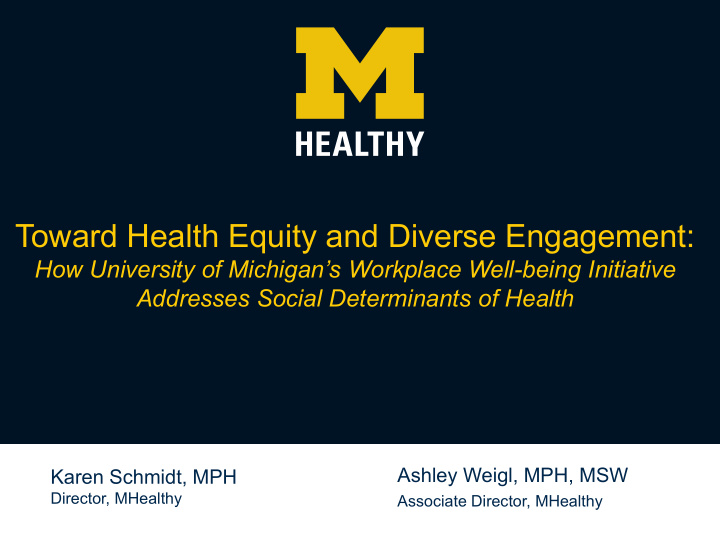



Toward Health Equity and Diverse Engagement: How University of Michigan’s Workplace Well-being Initiative Addresses Social Determinants of Health Ashley Weigl, MPH, MSW Karen Schmidt, MPH Director, MHealthy Associate Director, MHealthy
MHealthy
Diversity, Equity, and Inclusion at U-M MHealthy recognizes that: – health inequities exist in our employee population; – social determinants of health significantly impact health outcomes for members of our community; – health and well-being programs must be engaging to our diverse population to ensure maximum participation.
Equality vs. Equity
Some Definitions • Health disparity/inequality – a difference in health outcomes • Health inequity – a difference in health outcomes that is avoidable, unjust, and systematic. • Health equity: – achieving the highest level of health for all people
Social Determinants of Health
Social Determinants of Health Conditions in the environments in which people are born, live, learn, work, play, worship, and age that affect a wide range of health, functioning, and quality-of-life outcomes and risks. SDOH are responsible for most health inequities. https://www.healthypeople.gov/2020/topics-objectives/topic/social-determinants-of-health
Vulnerable Populations Low-wage earners Physical Chronic laborers Conditions High Health Risks
Determinants of Health Source: County Health Rankings model - University of Wisconsin Population Health Institute (2016)
What do the data tell us about lower-wage earners and health care utilization?
Healthcare costs for U-M full-time employees by income group, 2017 claims from Premier Care, Blue PPO, Blue CCM & HAP* <$35,000/yr >$35,000/yr ⍙ Employees 3975 34,258 Members 7697 74,188 Mean contract size 1.94 2.17 -11% Costs per member Net medical payments $4230 $4075 +4% Net pharmacy payments $885 $920 -4% Net total payments $5115 $4945 +3% Slide produced by John Ayanian, MD, Director of the Institute for Healthcare Policy and Innovation at the University of Michigan, in a March 2018 presentation to the MHealthy Advisory Committee
Healthcare use for U-M full-time employees by income group, 2017 claims from Premier Care, Blue PPO, Blue CCM & HAP Rates per 1000 members <$35,000/yr >$35,000/y ⍙ Preventive visits 568 678 -16% Other visits 3240 3117 +4% Mental health/substance visits 1341 1731 -23% Emergency department visits 338 190 +78% Inpatient admissions 71 59 +20% Inpatient days 260 217 +20% Slide produced by John Ayanian, MD, Director of the Institute for Healthcare Policy and Innovation at the University of Michigan, in a March 2018 presentation to the MHealthy Advisory Committee
Summary of Healthcare Costs & Use by Workers’ Income 1) Lower & higher-income workers have similar total health care spending 2) Lower-income workers use fewer preventive services & visits 3) Lower-income workers use fewer mental health / substance use visits 4) Lower-income workers use substantially more emergency department visits 5) Lower-income workers use more inpatient services Slide produced by John Ayanian, MD, Director of the Institute for Healthcare Policy and Innovation at the University of Michigan, in a March 2018 presentation to the MHealthy Advisory Committee
Primary Areas of Focus • Organizational supports and messages • Economic Insecurity – Meeting basic needs • Food Insecurity and Availability
Organizational supports • Internal EAPs • Emergency Hardship Fund • Scholarships for exercise classes • Re-frame messaging
Food Insecurity Pilot • Improving access to healthy foods and beverages for shift workers • Expanding food sharing cupboards in specific units • Regular fresh produce drop- offs and education • Connection to local pantry and cooking education resources in community, including student-run
Coaches for Well-being Pilot • 2 year pilot launching Q3 2019 • Coaches connect with individuals to navigate crisis management and address barriers to retention • Take a problem-solving vs. a correctional approach • Adapted from Success Coaches model • Partnering with
Staff Development • Regular dialogues on diversity, equity, and inclusion topics • Screening and discussion of “Unnatural Causes” • Departmental values identification
Focused Departmental Partnerships • Budget counseling • Building trust/forming relationships • Tailoring interventions for the unique needs of each population
Community Impact: Project Healthy Schools
Future Direction • Evaluation, scaling and sustainability • Maintain our curiosity – What else is possible?
Thank you! Questions? MHealthy at the University of Michigan mhealthy.umich.edu
Recommend
More recommend